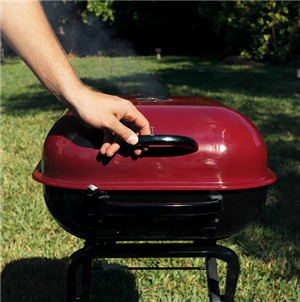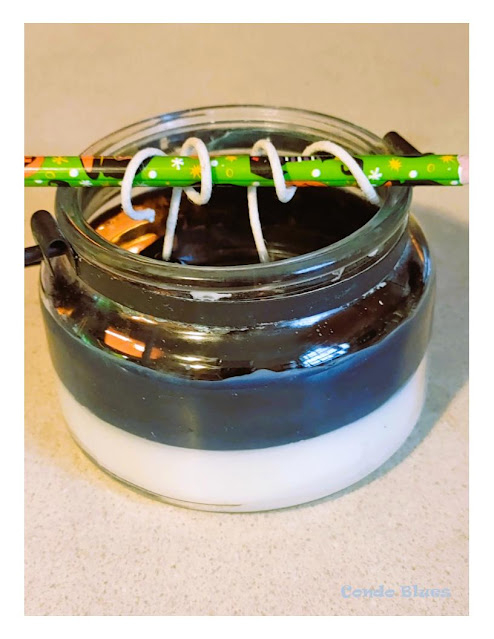As Midwesterners my husband I never really thought about making special
preparations for severe and tornado weather season (generally spring and fall.
Although tornadoes can form year round whenever warm and cold air collide)
beyond the school tornado drills we grew up with and lighting a few candles if
the electricity blinked out for an hour or so. We knew as long as we didn’t
open the refrigerator or freezer to keep the cold inside while the power was
out (the CDC says you have four hours without power before you have to throw
out the food) it’s all good.
Besides, my husband and I joked, if went went all Doomsday Prepper that stuff
would be scattered to the four winds if a tornado hit the house and so why
bother?
You can probably guess what happened next.
On a gorgeous summer’s day, the clear blue sky went dark like turning off a
light switch. The rain can down fast and furious with 75+ mile an hour winds.
The crazy, unexpected, snuck up on everyone including the weather experts,
storm was a derecho – the weather equivalent of smashing a water balloon on a
sidewalk as hard as you can.
Most of the city didn’t have electricity for a week afterward. We didn’t have
storm damage but we didn’t have a way to cook or keep food from spoiling
either. I guess we do need a tornado prep plan after all.
Save this post to your Pinterest Boards for later! Share it with your
friends!
How to Make an Easy Hurricane, Tornado, and Severe Weather Preparedness
Plan
What my husband and I learned from that experience, was that weather related
emergency plans should be made up of two parts:
-
What to do during the storm. Where is your home’s designated safe
space? Where should you go if you have to leave your home for a designated
safe space?
-
What to have on hand for after the storm. How to do what you need to do
during the day without utilities and/or city services. Not to mention, have
ideas for something to do while you wait for a return to services. It was a
very, very boring wait.
Please remember to include your pets in your plan!
How to Shelter in Place During a Hurricane, Tornado, or Severe Storm Warning
The first part of our emergency prep plan cost nothing at all. It was a simple
dinner conversation to discuss where we’d shelter when the tornado sirens go
off. A basement is your safest bet. If you do not have a basement, choose an
interior room without windows, a closet, or a bathroom on the lowest level of
your home and cover yourself with a mattress or blanket to protect you from
flying debris. Do not stay in your home if it is a mobile home, find a
designated severe weather shelter.
Keeping a weather radio (I have a
weather radio similar to this one
that can be charged by hand if need be) in that area is a good idea – which I
normally use as just a radio. It will allow you to get local weather
information without draining your phone battery. Although having a solar cell
phone charger to top things off when the power is out (or when camping) is
something I will never live without again! You can
learn more about the so epic I love it Big Blue Solar Battery Charger
here
that is worth every penny and then some. (Disclosure: I am including affiliate links for your convenience.)
What to Take With You to an Emergency Storm, Tornado, or Hurricane Shelter
According to the American Red Cross, they do not allow pets into their
shelters, only service dogs. Since that is not an option for us, we made a
plan with family and friends (and have a place for them if they need it) and a
list of hotels that allow dogs (some hotels may wave their No Pets policy in
an emergency but it is best to check to make sure.)
A surprising thing I learned about emergency shelters is that they pretty much
only provide a dry space to ride out the storm or aftermath and nothing else.
You may not have access to a kitchen to cook meals (that you have to bring,)
or a private shower. The Red Cross has information on what you should and
should not take with you to their emergency shelters which is good place to
start even though other organizations running storm shelters may have
different or lack of amenities.
If you have the time to pack before or after the severe weather hits and you
need to leave your home:
-
Bring a change of clothes, sleepwear, basic toiletries, medications,
etc – the same type of stuff you’d take with you for an overnight (or
longer) trip.
-
Bedding, pillows, sleeping bag, and consider a sleeping pad, cot, or a
self inflating air mattress like this one
. Most emergency shelters do not provide cots.
-
Food for several meals that does not need heating or refrigeration and water
to drink. A few comfort food snacks might be a nice idea. Most emergency
shelter do not provide meals.
-
Something to do – books, cards or board games, phone (backup batteries and
chargers,) etc. A surge protector power strip is a good idea if you have
room for it. Outlets may be a premium and you’ll be a hero if you
share!
-
A copy of important papers such as insurance policies, driver’s license, and
telephone numbers if you need to file claims or coordinate services after
the storm.
How to Prepare for a Blackout without Going Broke
The second part of our tornado prepper plan was what we should keep on hand to
prep for what happens after the storm – Namely cleaning up storm damage
if needed and what to do if your electricity, water, or natural gas service is
down while you are home.
This is the step where Doomsday Prepper culture goes nuts with recommending a
ton of expensive things and hoards of food for every imaginable scenario (if
that’s your thing – have at.) This is not that kind of plan. I don’t consider
myself a prepper and frankly in the two multi day storm related blackouts we
had (one in winter and one summer) most of those items weren’t necessary at
all.
I want to be prepared enough to stay warm and dry, keep a chunk of whatever
fresh/frozen food in the house from spoiling, see in the dark, and make coffee
– otherwise it
will be Doomsday.
In fact, all of the “special prepper gear” on this list is our regular tent
camping gear. The only key prepping ingredient is to learn from our first
storm mistake of not replacing the consumable items (propane, a heat and eat
meal or two in the pantry, etc) during the off season.
In other words, don’t plan to break in my house and steal a house full of
preps. The only thing I buy in bulk is dog food. You don’t want to make my
dog sad, do you?
Our Very Basic Extended Blackout and Severe Storm Preparedness Plan
Storm damage cleanup and repair
– If you already have gardening gloves and tools you’re set for most outside
cleanup. A few tarps and bungee cords may be a good idea to have if you need
to cover something that is damaged. You can
buy waterproof tarps here
and a useful for all occasions
bungee cord set here
– seriously we bungee everything for everything!
Light – I make sure I have
candles and matches on hand because I had more candle nubs than candles during
our blackout. Clearly this was a sign that I need to indulge my candle habit
more often!
It was also the motivation to make melting old candle nubs into new candles a
priority (truthfully, it’s more of way to enjoy the scented candles longer,
but any port in a storm.) I keep
tabbed candle wicks that I buy here on hand. I try to do the last burn of a candle when I have time to pour the
already melted wax into a new jar and add a wick to make a new candle. (Not
only am I a lazy chef but I am also a lazy candle maker.)
You can also do this with layering wax melt wax that lost their scent until
it fills the candle jar. It may not be as pretty, but it works when you need
it to!
A camping lantern, flashlights, or a headlamp is handy especially if you don’t
want to use an open flame around kids or pets. Last summer I upgraded to
this camping lantern that uses replaceable and rechargeable
batteries because our old lantern with a built in battery won’t hold a charge anymore
(this is typical for rechargeable batteries after ten years or so.) The old
lantern works if you plug it in which we still use for other things, just not
for blackouts and primitive camping.
The one thing we did do right was our habit of keeping all of our spare
rechargeable batteries charged. I use
this multi size rechargeable battery charger which is helpful (and cheaper than buying disposables) whether you
need them for a remote or a blackout.
Food will still be good in a
refrigerator without power for four hours. After that, consider saving what
you can in a cooler with ice if available, or outside if it is cold enough
during the winter. Whenever I use our cooler I pop one of these
freezer and refrigerator thermometers into the cooler from the fridge to easily keep an eye on food safety.
You can
read my How to Decorate a Cooler with Mod Podge tutorial on my DIY blog
Condo Blues here
You may also consider firing up an outdoor grill (I like
this portable grill
) and/or camping stove (we have
this kind of camping stove
) to cook and eat it immediately. If you are a coffee drinker I recommend
this Coleman Camping Coffee Maker that works on any camping stove just like a counter top coffee
maker. It makes a darn fine cup of coffee! The key is to make sure you have
fuel on hand which we of course didn’t at the time and was one of the things
that immediately sold out at the store.

During our blackout many people had an impromptu block parties
because everyone decided to grill the food food melting in their freezers
instead of throwing it out.
As for what type of food to keep and cook, that is entirely up to you. My food
allergy means I can’t eat most prepared and canned food so of course we didn’t
have even the stuff I can eat in the pantry during our storm blackout either.
We were fortunate to live near restaurants that either had power or giant
generators but the lines were long and it got old real quick.
Now I try to keep a few things in the pantry like a couple of cans of our
favorite local chili (I usually make it from scratch,) or stuffed grape leaves
(who says you have to suffer during an emergency?) Nothing too crazy or
obscene amounts. Just things we normally like to eat on occasion that don’t
require storing in a cooler or refrigerator for power outages or comfort food
emergencies. If your home’s water relies on an electric pump, you may consider
storing water too. The CDC suggests storing 1 – 2 gallons of water per person
and pet per day.
The only other thing left to do is find a way to fill the time while you are
waiting for your utilities to come back on. It’s a very good time to catch up
on your reading!
Looking for more storm, tornado, or hurricane preparedness ideas? Check out
the following options – and more! - below!
Did you like this post? Get more like it by
subscribing to the Lazy Budget Chef RSS feed






Comments
And thanks for joining the Grace at Home party at Imparting Grace! I'm featuring you this week.
Post a Comment
Share what you have to say! The good and the not so good. Disagreeing is fine but no hair pulling please. Thanks!